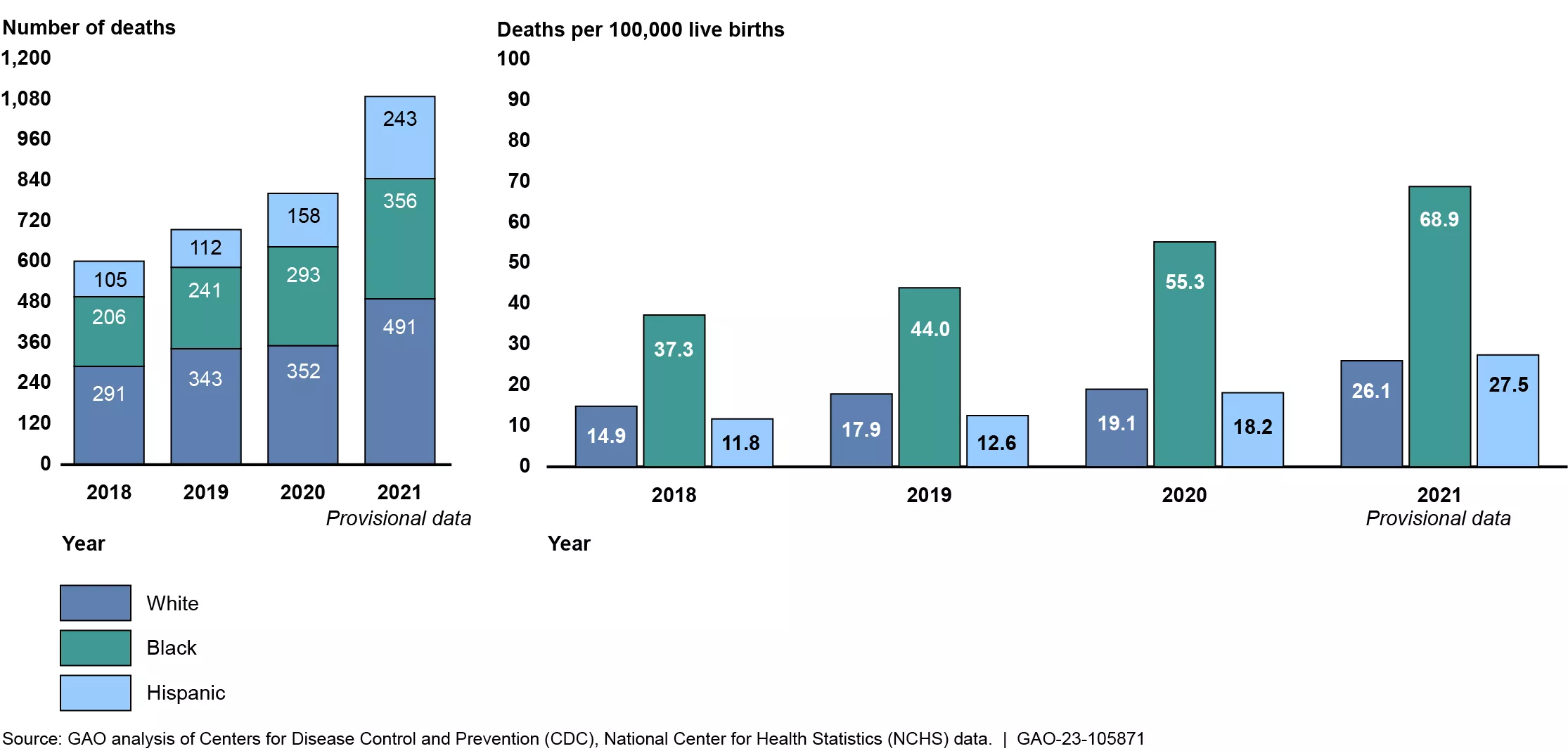Women and Gender in Public Policy
Issue Summary
While federal laws prohibit discrimination on the basis of sex, gender disparities persist in education, employment and earnings, retirement, health, violence, and other areas covered by federal programs. Women are more likely to be concentrated in low-wage jobs, be responsible for caregiving, and experience sexual harassment and assault. Additionally, the United States has the highest rates of maternal death of developed countries, with U.S. maternal mortality rates increasing when rates have decreased globally. Other issues, such as certain kinds of school discipline and bullying, may affect boys and gender minorities disproportionately.
Federal agencies could more effectively design, implement, and evaluate programs and policies to help address such issues.
For instance:
- Women in management. Women continue to be underrepresented in management roles in the U.S. workforce, and female managers continue to earn less than male managers. In 2021, women working full-time earned an estimated 76 cents for every dollar that men earned across all industries and the pay gap was greater for managers than for non-managers. Among full-time managers, the pay gap also varied considerably across racial and ethnic groups.
Full-time Female Managers’ Estimated Average Pay for Every Dollar Earned by Full-time, White Male Managers, 2021
Image

- Financial security. Older women have a longer life expectancy, on average, than older men. And the challenges women face during their working years can affect their lifetime earnings and retirement income. For instance, women are paid less money than their male counterparts during their careers and more likely to leave the workforce to care for family members. Taken together, these trends may significantly affect women's financial security in retirement.
- Women in STEM. Women are still largely underrepresented in science, technology, engineering, and math (STEM) professions. And female students in engineering and medical majors experience sexual harassment significantly more than female students in non-STEM fields. Relatedly, the financial services industry is increasingly dependent on technology. Because women continue to be underrepresented in management positions in the financial services industry and in STEM degree programs, some financial services firms are trying to increase women's interest in STEM by supporting nonprofits that introduce girls to STEM activities (like coding), and by increasing college-age women's awareness of careers in the industry.
- College athletics. In 1972, Title IX required equity for women in college athletics. Yet 50 years later, women still participate in college athletics at lower rates than men—despite enrolling in college at higher rates. The Department of Education’s Office for Civil Rights assesses compliance with Title IX. However, it didn’t always follow up with colleges in a timely way to make sure they were addressing concerns about women’s athletics. Additionally, high-profile cases at multiple colleges have raised concerns about sexual harassment and violence against athletes. But college sports culture may make it hard for college athletes to report incidents of sexual harassment or violence—which may also be Title IX violations.
- School dress codes. Nearly all public school districts require students to adhere to dress codes. While school districts often cite safety as the reason for having a dress code, many dress codes include elements that may make the school environment less equitable and safe for students. For example, an estimated 60% of dress codes have rules involving measuring students' bodies and clothing—which may involve adults touching students. Consequently, students, particularly girls, may feel less safe at school. Further, school districts more frequently restrict items typically worn by girls—such as skirts, tank tops, and leggings—than those typically worn by boys (like muscle shirts). The Department of Education is considering options to provide helpful resources to stakeholders and the public but has not yet done so.
- Maternal health outcomes. Hundreds of women die of complications related to pregnancy and childbirth in the U.S. every year, and women of color are disproportionately affected. For example, Black women are nearly 3 times as likely to die from childbirth as White women. Additionally, maternal deaths increased during the pandemic—especially for Black women. The Department of Health and Human Services’ Healthy Start program works to reduce racial and ethnic disparities in maternal and infant health outcomes. However, this program may be hindered by a lack of clear and reliable performance measures to assess progress.
Number and Rate of Maternal Deaths by Race and Ethnicity, 2018 through 2021
Image

- Sexual harassment at work. Sexual harassment in the workplace can cause harmful psychological, physical, occupational, and economic effects for harassed employees. A federal survey estimates that more than 1 in 4 employees (29%) at the Federal Emergency Management Agency (FEMA) experienced workplace harassment or discrimination based on sex or race/ethnicity, according to a 2019 survey. FEMA has taken action to address workplace discrimination and harassment but has not taken steps to determine the effectiveness of its efforts.
- Women in the military. Unwanted sexual behavior that occurs during military service—including sexual harassment, sexual assault, and domestic sexual abuse—undermine core values. Female officers in the military had higher annual attrition rates than men, and cite family planning, sexual assault, and dependent care as reasons influencing separations. The Department of Defense (DOD) could improve its guidance to monitor recruitment and retention efforts of female active-duty servicemembers. Additionally, women and members of historically disadvantaged racial or ethnic groups make up lower percentages of the DOD civilian workforce relative to the federal workforce. To better track DOD's progress with eliminating barriers to workforce diversity, the agency should identify which office is responsible for oversight.
- Sexual assault forensic exams. Sexual assaults in the United States increased by an estimated 64% from 2021 to 2022. Survivors may seek an exam and related medical treatments from a health care provider, and such exams must be free of charge under federal law. Coverage for related medical treatments, however, varies in states, counties, and on tribal lands.
- Violence against American Indian and Alaska Native women. Violence against American Indian and Alaska Native women is a crisis, and cases of missing or murdered Indigenous women persist nationwide. The Justice Department should develop a plan for analyzing data that could help identify relevant trends in cases of missing or murdered American Indian and Alaska Native women.
- Domestic violence and sexual assault survivors. The Department of Housing and Urban Development requires that its housing providers have emergency transfer plans to move survivors of domestic violence or sexual assault from their current housing unit to one in another location. While most housing providers had emergency transfer plans, they often didn't specify how transfers would take place. Additionally, sexual violence survivors in college may suffer academic and financial consequences. The Department of Education has loan postponement and repayment options that can help survivors manage their federal student loans. Additionally, federal data on domestic violence is lacking, especially as it relates to brain injuries resulting from such violence.
- Human trafficking. Human trafficking victims are often held in slave-like conditions and forced to work in areas like the commercial sex trade, factories, and agriculture. Several federal agencies have programs to prevent trafficking, prosecute traffickers, and protect survivors. However, staffing gaps, unclear roles, and weaknesses in monitoring have impeded some efforts. Additionally, the internet has made it easier for sex traffickers to exploit victims and connect with buyers.
- International aid. The U.S. Agency for International Development’s (USAID) Bureau for Global Health supports health programs across the world. However, the agency has not assessed Bureau-level performance and lacks key information to evaluate its results—including child and maternal health data for 18 countries that have received more than $200 million from 2019 to 2021. Additionally, USAID is required to spend at least $265 million a year supporting very small businesses and must give some of this money to benefit the very poor and women. However, the agency hasn’t collected the data to monitor these activities and is unable to determine how much money reaches these groups.


